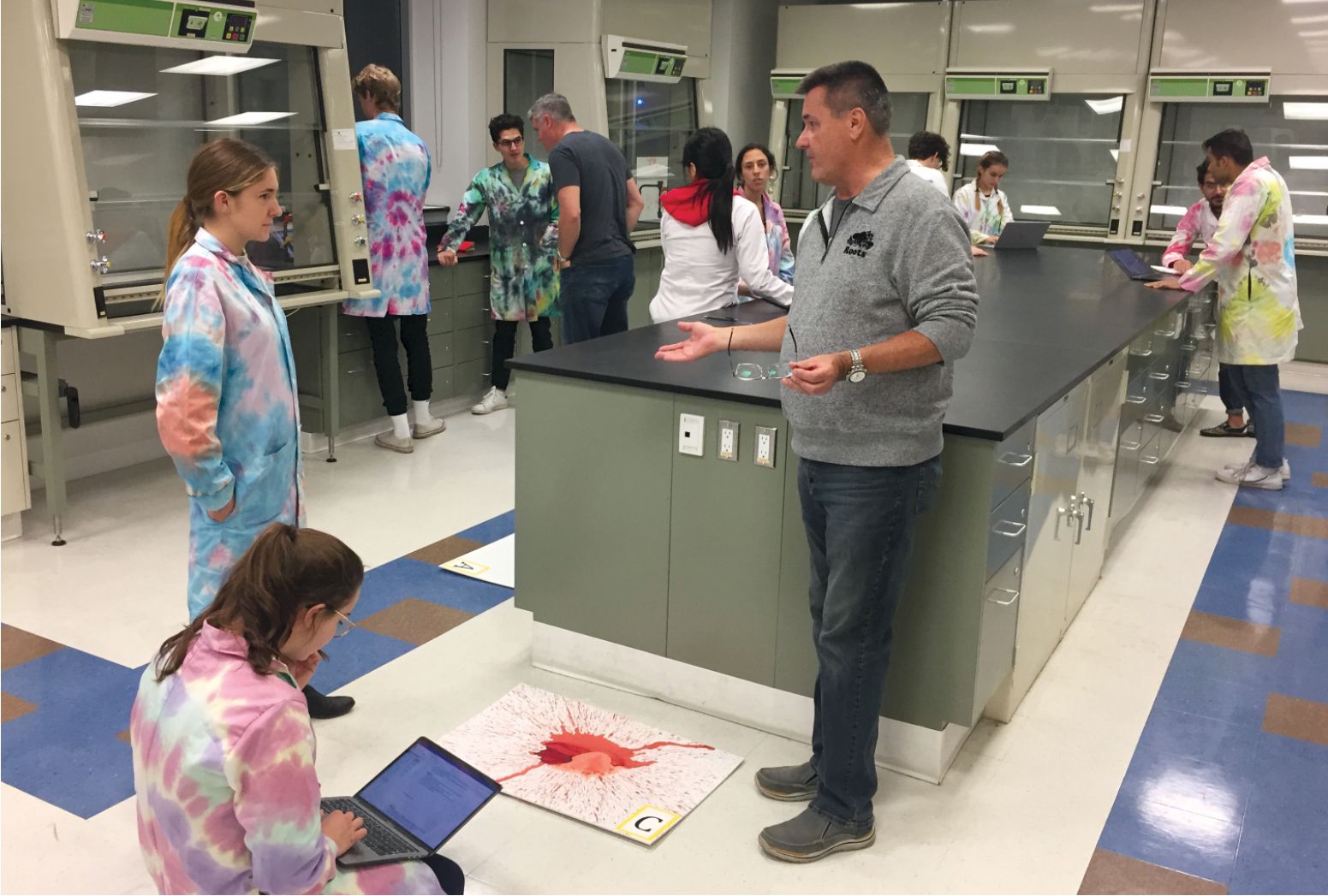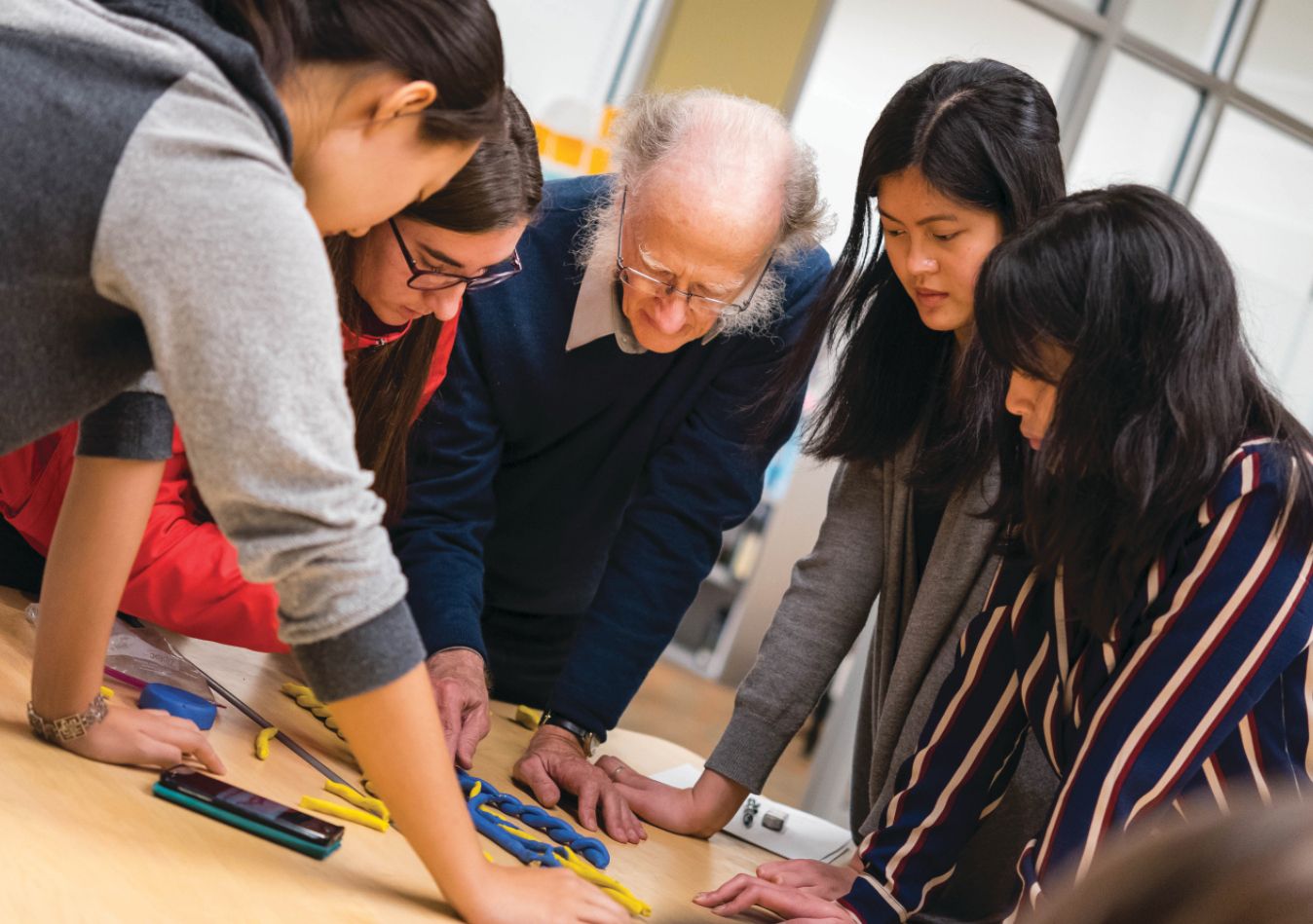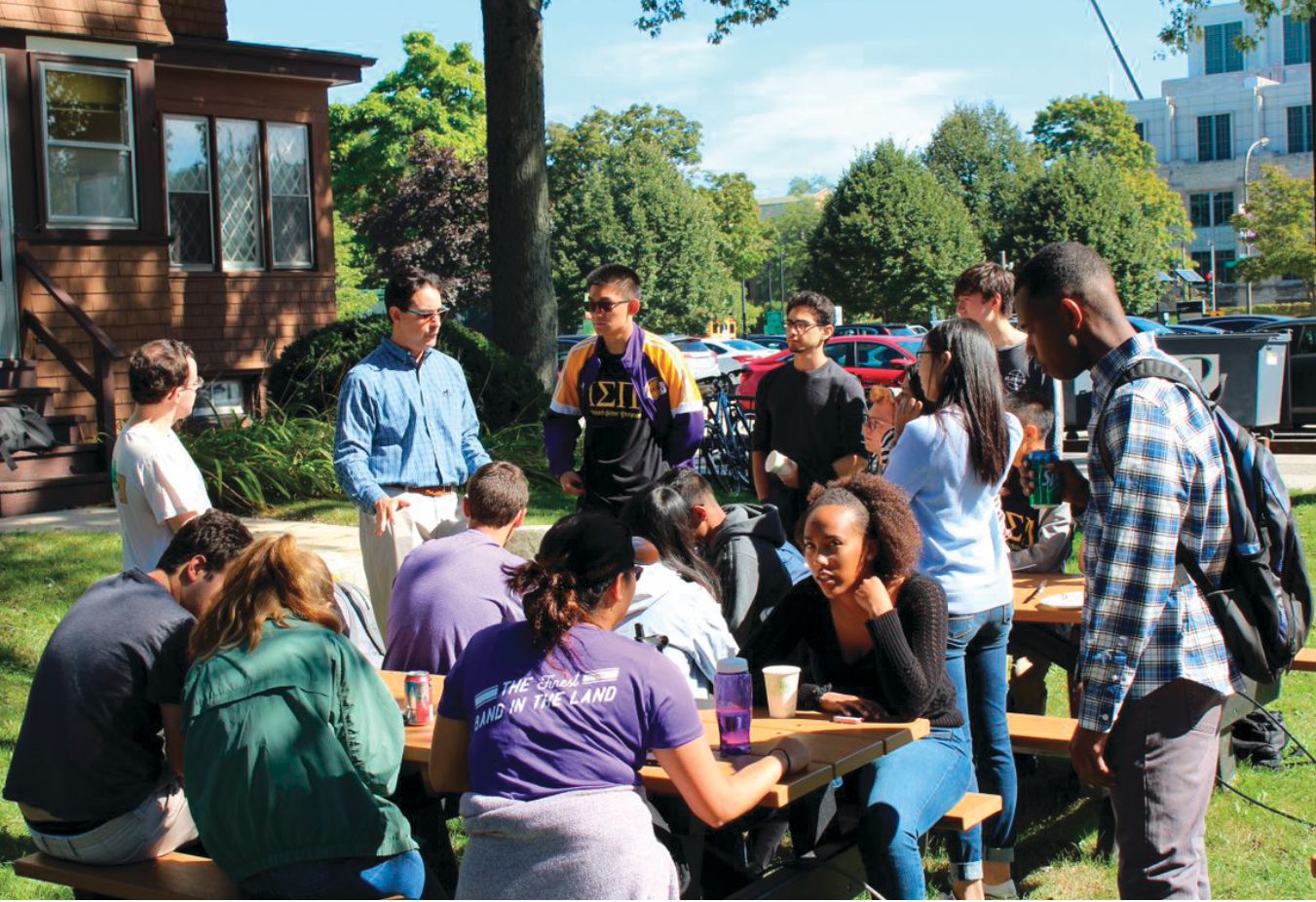Undergraduate integrated science programs foster interdisciplinary and personal connections
DOI: 10.1063/PT.3.4853
In the early 2000s, Derek Raine, a physicist at the UK’s University of Leicester, spearheaded a program to immerse undergraduates in physics, math, biology, and chemistry in a setting that highlights commonalities across those fields. In the ensuing years, the program has changed with political and financial winds, but key elements persist: It experiments with new teaching methods, emphasizes teamwork, and embeds communication skills.
For several decades, researchers around the world have been encouraged to forge connections across disciplines; funding agencies, for example, commonly call for joint proposals from researchers in different fields. A smattering of programs, some founded earlier than the one at Leicester, introduce that philosophy at an earlier stage in people’s education.
Several Canadian universities have embraced integrated approaches to teaching science, and a few programs exist in the US and elsewhere. Some programs last four years, such as those at Leicester; at McMaster University in Hamilton, Ontario, Canada; and at Northwestern University in Evanston, Illinois. Others, including the Science One program at the University of British Columbia (UBC) in Canada, are intensive, nearly full-time programs for first-year students only. And some, such as at Harvard and Princeton Universities, represent a smaller portion of course credit but share similar aims of teaching students to recognize and make connections across fields.
“The workforce has a need for a wider cohort with interdisciplinary skills,” says Raine, whose research has ranged from quantum field theory to biophysics. “We have to get that message across. It’s hard.”

Blood spatter. For a module on forensic science, third-year students in the McMaster University integrated science program reconstruct the angle of impact, velocity, and distance traveled by blood in a mock accident scene.
RUSS ELLIS

Problem-solving
Meghan Scott has a year to go in the integrated science bachelor’s program at Western University in Ontario. She took required classes she may have otherwise passed over—Big Data and Mathematical Modelling, for one. The courses were interdisciplinary and project-based. Learning how sciences can be applied to help address issues like world hunger, the pandemic, and climate change has been pivotal, she says. She credits the integrated science program with her choice to major in physics: “I came into university not liking physics, but I found I liked solving problems.”
Darren Fernandes graduated from college in 2013 with the first integrated science cohort at McMaster. The program attracted him because he loved science but hadn’t yet settled on a direction. In integrated science, Fernandes enjoyed working on open-ended projects and leveraging the strengths of partners in group assignments. “I was so enamored of the science I was learning,” he says, “it was only in graduate school that I realized I had gained a huge advantage: I can communicate with scientists in many fields.”
When he was a doctoral student in medical biophysics at the University of Toronto, Fernandes’s ease in traversing disciplines proved useful. In trying to understand the social behavior of mice, he had an aha moment: Could he model mouse movements as an ideal gas with a tiny additional attractive force? The model described the mice well, he says. “You can find individual-specific traits over long times. Hopefully the approach will transfer to humans—for example, to help understand autism.” He is now in his final year of medical school.
Fundamentals and friendships
Integrated science programs tend to function as small schools within their host universities. They typically enroll 20–80 students and have a high instructor–student ratio, often around 1:10. Julia Liu is an alumna of Princeton’s integrated science program who majored in physics and is now an assistant professor of integrative biology and physiology at the University of Minnesota. “The main thing I got out of participating in the program was the feeling that I could learn anything,” she says. “I have the foundational background, even if I’m not an expert. And the camaraderie of our class was tremendous.”
In some programs students can graduate with a bachelor’s degree in integrated science; others require a separate or double major. The McMaster and Leicester programs, for example, award degrees in integrated science, and many students choose an additional area of concentration. In the first year, the programs represent the lion’s share of the students’ coursework; in subsequent years the integrated science part of the curriculum goes down.

Jim Berger at the University of British Columbia employs modeling clay to teach students in the integrated science program about meiotic recombination.
PAUL JOSEPH

Early in the first year of the McMaster program, environmental geoscientist Carolyn Eyles introduces plate tectonics. In parallel, physicist Robert Cockcroft teaches about friction. “It matches beautifully,” says Eyles, a founder of the university’s integrated science program. In Canada, she says, most students don’t learn about geosciences in high school. The integrated science program highlights that Earth sciences are a good vehicle to study topics such as how climate change will affect water supply and how geoscience applies to the exploration of other planets, says Eyles. “They get exposed to research and career opportunities.”
On average, about 15% of students who continue on to graduate school from the McMaster integrated science program pursue an Earth sciences field, says Eyles. “It’s a much higher uptake than I ever expected.”
Northwestern University launched its integrated science program in the 1970s with the aim of attracting strong science students. Courses are offered by participating departments rather than being developed by a dedicated core team of instructors, as in many of the other programs. It focuses on neuroscience and geoscience in addition to math, physics, chemistry, and biology. Along the way, participants fulfill the university’s general education requirements; elsewhere such requirements may be woven into the integrated science curriculum.
Northwestern integrated science students can graduate with a major in integrated science after three years, although most stay a fourth year and double major, says André de Gouvêa, who was program director until the end of August. The program draws 25–35 students a year.
The Princeton and Harvard programs each consist of a yearlong double course. Princeton’s, which was established in 2004, began as a multiyear program aimed at life scientists but has morphed into a one-year program that serves all the sciences. The six-year-old Harvard program is geared to life sciences. “We emphasize the connections between quantitative and physical sciences and biology, which are becoming increasingly relevant to research in biology,” says biophysicist Michael Desai, one of the course’s founders.
Science One, the integrated science program at UBC, launched in 1993. Some 150–250 applicants vie for 80 spots each year. It covers physics, chemistry, biology, and math, says director James Charbonneau. Computer science, ethics, and scientific literacy are woven into the curriculum, partly through projects and student-led conferences. In nonpandemic times, incoming students take a four-day field trip to a marine sciences center, where they learn biology and biophysics and get to know each other.

Students in Northwestern’s integrated science program enjoy a pre-pandemic picnic in front of the house where they study and socialize.
NORTHWESTERN UNIVERSITY

Often faculty sit in on each other’s teaching modules, says Charbonneau. “We pipe up and have conversations in class. The students see scientists interact in real time.” As an example of “de-siloing” the sciences, he says, students might apply computational methods to ecological questions such as how energy moves from one species to another. They build computational models that include the Sun, plant growth and death, and animal behaviors. Terminology for the same concepts—entropy, energy, work, gradients—can be different in different sciences. “We are breaking down communication barriers, translating,” he says. “Typically, in the first year, students will not notice the connections unless you point them out explicitly.”
Comparisons of performance in upper-division courses indicate that Science One alumni outperform their peers who had similar marks in high school. Faculty from the integrated science programs at various schools point to the success of their graduates. “They are well prepared, and they know how to think critically,” says Sarah Symons, coordinator of McMaster’s integrated science program.
“The way our integrated science program teaches is not just equations,” Symons says. “We are trying to get at how to do science, how to communicate, how to accrete knowledge. You need to understand science’s place in society, how science interacts with people’s lives, and how scientists interact with one another.”
Cost and commitment
“If these programs had been around when I was a student, I would have wanted to attend,” says Cockcroft, who helped start the integrated science program at Western University in 2016 before rejoining McMaster in the summer of 2020. The appeal, he says, includes small class size, the bonds that develop between students and faculty, the close teamwork among faculty, the exposure to a wide range of sciences, and the confidence with which graduates are able to discuss ideas and present their work.
So why are there so few integrated science programs? And what do they need to succeed? One barrier is cost, especially at the development stage. “We were lucky to have external funds,” says Raine; the Leicester program was initially funded through the UK’s Institute of Physics in an effort to boost the number of physics students.
Startup costs aside, it’s more expensive to support classes with student numbers in the low double digits than in the hundreds, as in many introductory math and science classes. And the multidisciplinary experiments can be pricier than those in traditional lab courses. UBC spends about twice as much on an integrated science student as it does on a traditional science major, according to “Are we doing any good? A value-added analysis of UBC’s Science One program,” by UBC faculty members in the December 2012 issue of the Canadian Journal for the Scholarship of Teaching and Learning.
Perhaps a bigger barrier is the investment needed. Setting up any new teaching program requires commitment from faculty members and buy-in from the university administration. These programs need someone to champion them, says Raine. “Not everyone is on board. Many academics think we are spoiling the purity of the disciplines.”
Thomas Gregor, a biophysicist at Princeton, says organizing courses for the integrated science program is a huge amount of work. “You have to coordinate something like 15 instructors.”
And, of course, students have to sign up. Across all of the programs, students and faculty say that integrated science requires a bigger commitment from students than a traditional science path does. The one-year programs are aimed at freshmen, notes Gregor. “They are away from home and their parents for the first time, and they have to sign on to an intensive course. They have to give up extracurricular activities. They can’t party more than one night a week or they’ll fall behind.”
The programs at UBC and McMaster are well known and oversubscribed. But high school students—and their parents—rarely recognize the value of “integrated science” and may prefer to stick with known quantities. It’s easier for prestigious schools to risk launching such programs, notes Northwestern’s de Gouvêa. They can afford the startup costs, and even an unfamiliar certificate from the likes of Harvard or Princeton looks good.
A program that integrated math, physics, chemistry, and engineering in the 1990s at North Carolina State University was dropped after four years because it overstretched faculty resources. Still, says Robert Beichner, a physicist and one of the program’s founders, faculty “adapted the innovative teaching approaches to other settings.” The most exciting research finding from those adaptations, he adds, is that they erase correlations between student demographics and performance. “All students benefit.”
A six-year-old integrated science program at York University in Toronto was suspended this year because of declining student numbers. Despite a good start and enthusiastic leadership, it hadn’t quite gotten off the ground when a labor disruption and then the pandemic took swipes at enrollment.
Integrated science programs are small and tend to serve as prestigious flagships for a university, notes Tamara Kelly, a founder of the York program. “We had to decide whether to do a small elite program or a larger one aimed at a broader range of students,” she says. The dean’s office opted for attracting top-performing students. But, she adds, “the approach is good for all students, particularly mid-performing ones who might not see the links between the fields.”
Integrated science programs, says McMaster’s Symons, are good for people who don’t know what they want to do but love science. “They are good for people who like to ask questions—that’s easier in small classes. And they are good for people who want a say in their education.”
More about the Authors
Toni Feder. tfeder@aip.org
